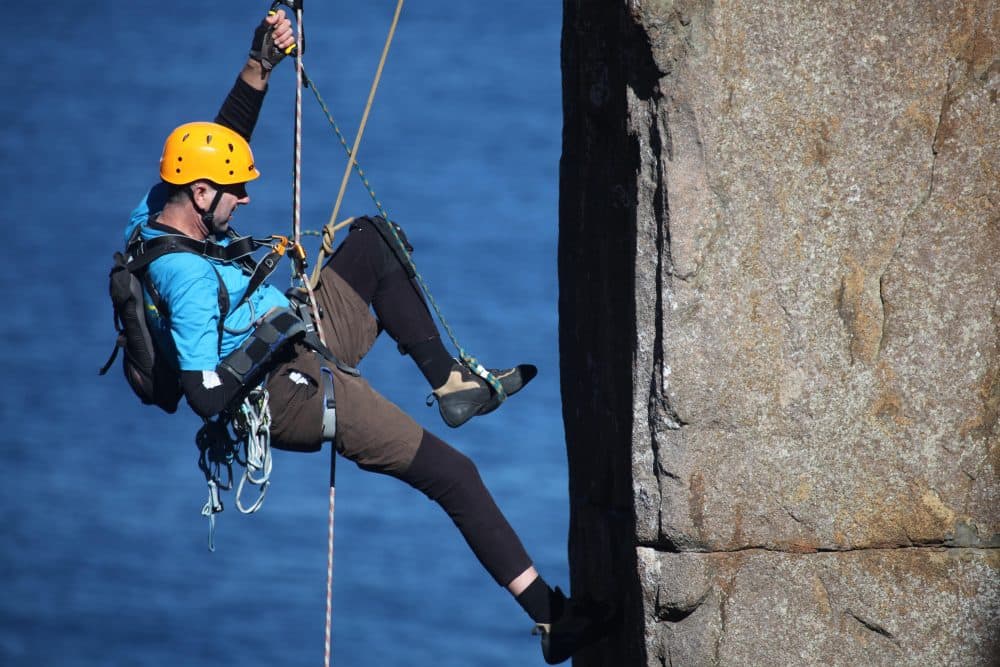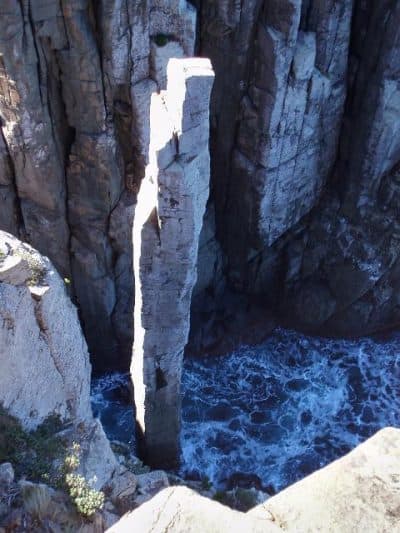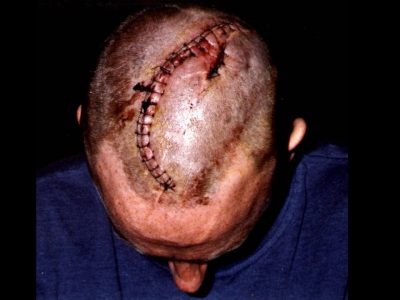Advertisement
Climber Paul Pritchard Returns To Sea Stack That Nearly Killed Him
Resume
Paul Pritchard worries about how he talks. Sometimes he worries enough to think he should apologize.
"I hope you realize that my speech is a bit stilted because of my head injury," he says.
Pritchard grew up in Wales. As a youngster, he was no athlete, which may have explained, at least in part, why he had the leisure to dabble in delinquency.
"When I was young, when I was about 14, I was a bit of a bad lad, and I used to throw petrol bombs at climbers and set the moors on fire," Pritchard says.
Happily, before he could travel far on the path to criminal excess, young Pritchard was rescued — and it wouldn’t be the last time that happened.
"A teacher said that we could go climbing instead of doing football or some other team sports, which I was always rubbish at," Pritchard says. "And so I tried climbing and found that I was good at something for the first time in my life, and that really calmed me down."
Tasmania's Totem Pole

Climbing was life-changing. Pritchard says moving up and along a rock face was "like poetry." The better he got at it, the more ambitious he became. Eventually he was recognized as one of the most accomplished climbers in Great Britain. And then one day he came across a magazine photograph of a sea stack in Tasmania called the Totem Pole. A sea stack is a kind of pillar that rises from the ocean near the coast line. You can find them in lots of places.
"But this one was the most slender sea stack in the world," Pritchard says. "It was 4 meters wide by 65 meters high. And It was just absolutely amazing, this picture. And when you see the Totem Pole, it’s one of the wildest kind of things that come out of the sea in the world. It even sways in the wind, it’s so flimsy."
So of course Paul Pritchard decided he’d better climb it. On Friday, Feb. 13, 1998, at the age of 31, off he went to the Totem Pole. But when he and his then-girlfriend, Celia, got their first look at it...
"It actually appears quite disappointing, because the headland is 120 meters high," Pritchard says. "And the Candlestick, which is beyond the Totem Pole, is a 120-meter high sea stack, but the Totem Pole is only 65 meters high, so you struggle to see it when you first look down upon it. But then when you get level with it, that’s when you see it in all its glory."
Paul and Celia climbed down the headland until they were level with the top of the sea stack. Then they made their way to the top of the Totem Pole via a rope strung between the cliff and the summit of the stack. The plan was to climb down from the summit, then climb back up and call it a day. Part one of that plan went well enough. Paul went first.
"And I made — I put my rope ascending clamps onto the rope, and I took up the slack about five moves, and then swung around the edge, like a corner of a house," Pritchard says. "And that’s the last thing that I — I didn’t notice any sound or even a strike. The next thing that I remember was that Celia was by me, trying to get me upright in slings. Blood was pouring from my head into the sea, because I was upside down."
Paul Pritchard had taken a rock to the head — a rock about the size of a flat screen computer monitor. It had fallen 30 feet and cracked his skull before dropping into the sea. Bits of the rock were left behind in Pritchard’s brain. Celia climbed down to Pritchard and began hauling him up the cliff.
"And the first time that I remember that something was drastically wrong with me was when she was trying to get me onto the ledge three hours later, and I was drifting in and out of consciousness," Pritchard says. "She said, 'You’re gonna have to help me here, if we’re to get you out of this.' And I tried to help her, and that’s when I realized neither my right arm nor my right leg were working. They were like a corpse’s."
Somehow Celia maneuvered Pritchard into a position where he could use his left hand to pull himself onto the ledge. She secured him and went for help.
"God knows what was going through her mind then," Pritchard says. "She was probably thinking that it was the last time that she’d see me alive. And then she had to run 8 km for help, because it was in the days before mobile phones."
Alone on that ledge, Paul Pritchard wondered whether he’d live. He knew he was still losing blood. He knew that he hadn’t been able to move enough to help much with his own rescue.
"I knew that I’d done something really awful to myself," Pritchard says. "I knew that I had to stay awake. I thought that if I did go to sleep, it might be the last sleep that I ever made."

About eight hours after the accident, Celia and a paramedic named Neal Smith returned to the Totem Pole. It wasn’t easy, but they managed to get Pritchard off the rock. He found himself suspended above a small boat.
"We call them 'tinnies' in Australia," Pritchard explains. "And the swell was such that it was rising and falling for about 6 feet. And so Neal had to take his pen knife and cut the rope just on the upswell, so we fell into the boat. It was quite dramatic. I’d lost half my blood."
After another two hours, Paul Pritchard finally reached a hospital, where doctors would begin to assess the damage.
"Then they put me into an induced coma for four days," Pritchard says. "When I came around, out of that coma, I didn’t know where I was. I thought that the nurses were trying to kill me. I was really hallucinating badly, but I think it was the drugs they put me on. I found that I couldn’t talk. I was really confused. My right arm and right leg felt still. They were cold. My face was all droopy on the right side, so it was like a massive stroke."
An Ongoing Climb To Recovery
In the frightening months that followed the accident, a couple of doctors told Pritchard he’d never walk again. Sometimes he felt depressed. On the other days he despaired.
"Because I thought that I would never climb again," Pritchard says. "And I had a whole room full of expedition gear — ropes, and sleeping bags, ice axes, crampons — I decided to sell it all. I remember crying once when this guy came asking to buy my skis. You know, I was so depressed that I needed medication."
At some point during those days, Paul Pritchard began to realize that the climbing he’d done had prepared him for the challenges he was now facing. As he put it, the mountains had been a good teacher.
Pritchard was in a wheelchair for about nine months, a wheelchair he had to operate with only one hand, which was frustrating. Who wants to travel in circles? Maybe that’s where he found the determination to teach himself to walk again, and then to climb.
"About 18 months after my accident, I climbed a hill in Wales," Pritchard says. "It took quite a few hours. It was just a small hill above my village."
Five years later, Pritchard climbed Mt. Kenya. Two years after that, in 2005, in the company of an all-disabled team, he climbed Kilimanjaro.
But even as he was taking on those challenges, Pritchard encountered hostility. He was beaten up — once in the street, once at a party. He could see no reason for it, beyond the fact that he struggled to walk and to talk.
Pritchard continued to climb. He says part of it was just wanting to get back to the joy of being outdoors and sleeping in the dirt.
"If you’re a disabled person, it seems like you can really only ever be one of two things. That’s either a passive victim or someone who’s succeeding against all odds. And I’m neither. I’m just a normal bloke, really."
Paul Pritchard
Simultaneously, recovery was teaching Pritchard something about the brain, or, at least, his brain, within which the undamaged parts were beginning to compensate for what had been lost.
"You never stop recovering," Pritchard says. "It’s not like a peripheral nerve injury, like a broken back or something, where you don’t really ever recover. So, for me, even two years ago, 16 years after my injury, I started to be able to tap my foot."
"So it’s something new everyday," I say.
"Well, maybe something new every year," Pritchard says. "It’s pretty slow, this plasticity business."
Meanwhile, Pritchard and his climbing buddies began devising a system of ropes and pulleys that would enable Paul to undertake more ambitious climbs.
Back To The Totem Pole
You can see where this is headed, right?
Those innovations, his own determination and that plasticity Pritchard mentioned eventually enabled him to return to the scene of his accident. In April of 2016, he went back to the Totem Pole.
"The Totem Pole, for me — it caused me so much pain, and it needed to be returned to," Pritchard says. "I think that to come full circle after 18 years, it was something quite profound about it. I took the very same swing that I took all those years ago which caused me so much damage, so that was really, really quite frightening for me, and then I had to climb up this rope to the ledge with my one hand. And pulling onto the ledge, I had these really powerful flashbacks of Celia shouting to me in my brain. And then, when I actually got onto the summit, my legs were below the summit, and my body, my torso was above it, and it was the same deal, really, as when I was trying to get onto the ledge the day of my accident. And then that was it, I was on the summit and it felt like I was realizing a long-held dream."
Returning to the Totem Pole and completing that climb brought Paul Pritchard considerable attention, especially in Australia, where he now lives. These days, he still climbs — and bikes, and kayaks on adapted machinery — but he also visits schools one day each week to demonstrate what a disabled person can accomplish.
"If you’re a disabled person, it seems like you can really only ever be one of two things," Pritchard says. "That’s either a passive victim or someone who’s succeeding against all odds. And I’m neither. I’m just a normal bloke, really. I may seem to be succeeding against all odds, but that’s positive discrimination. I don’t climb anywhere near as hard as I used to. I don’t feel special in any way."
Having heard Paul Pritchard’s story, you may feel otherwise. His protests to the contrary, he’d probably understand.
This segment aired on February 11, 2017.
